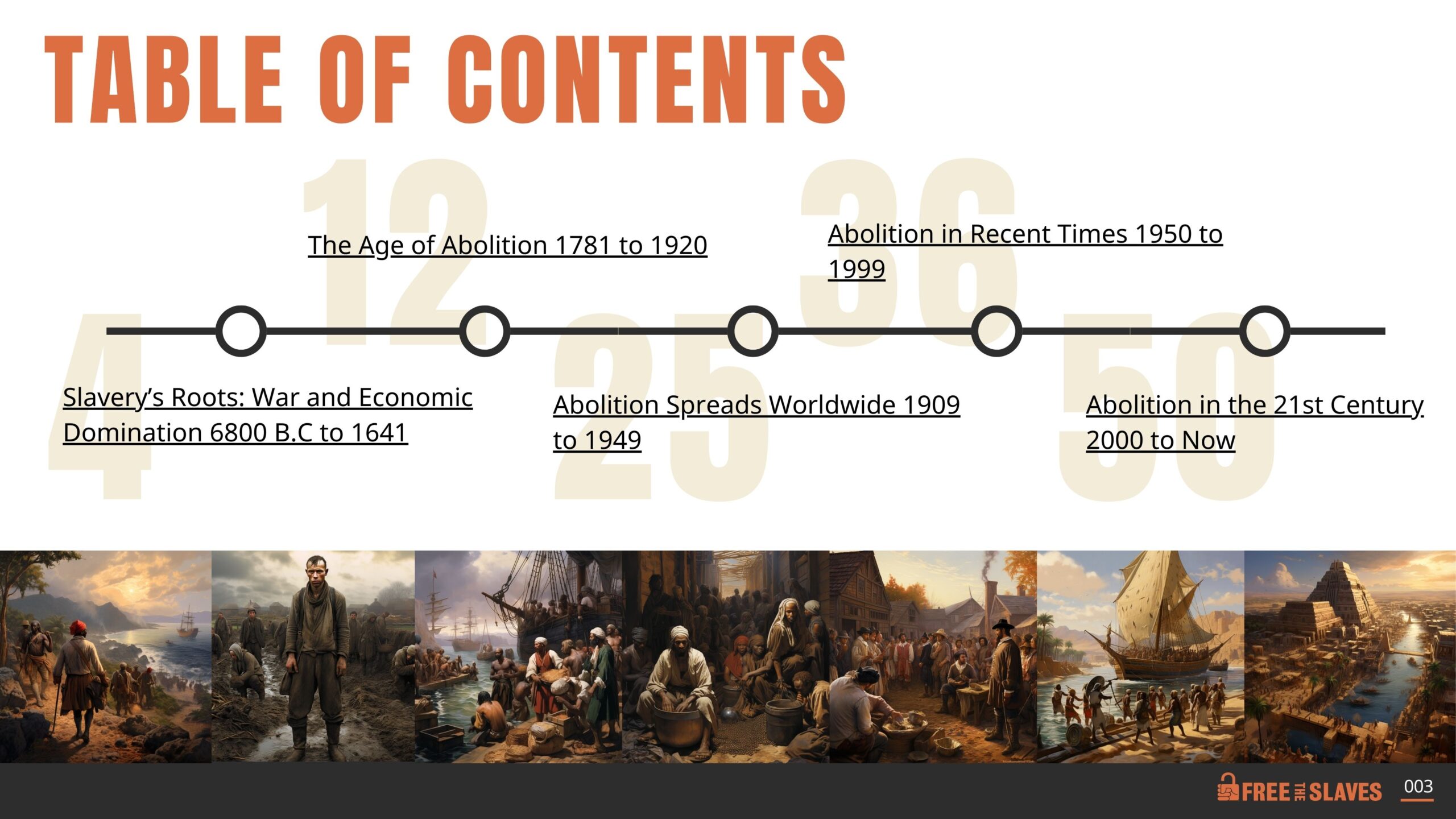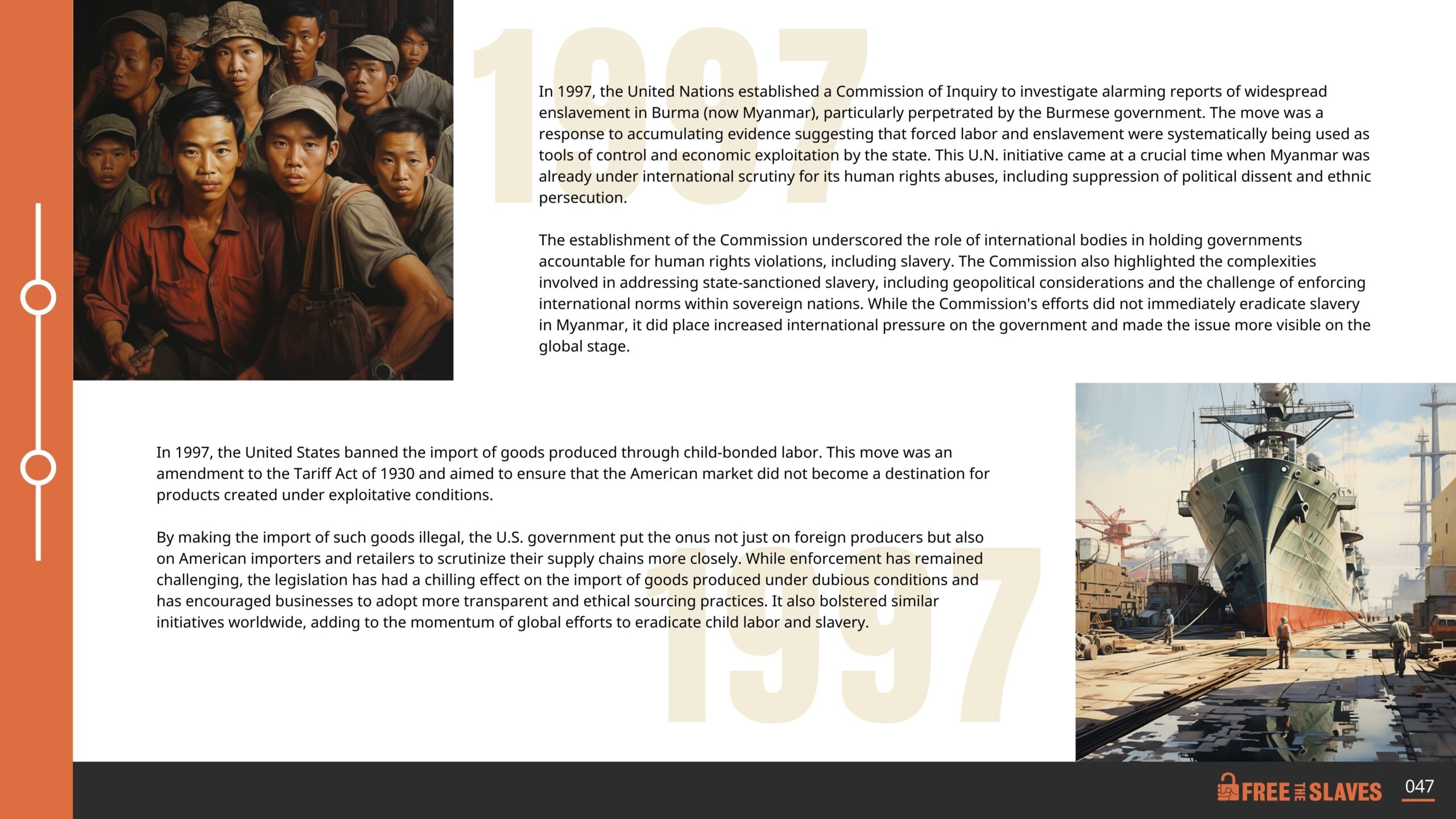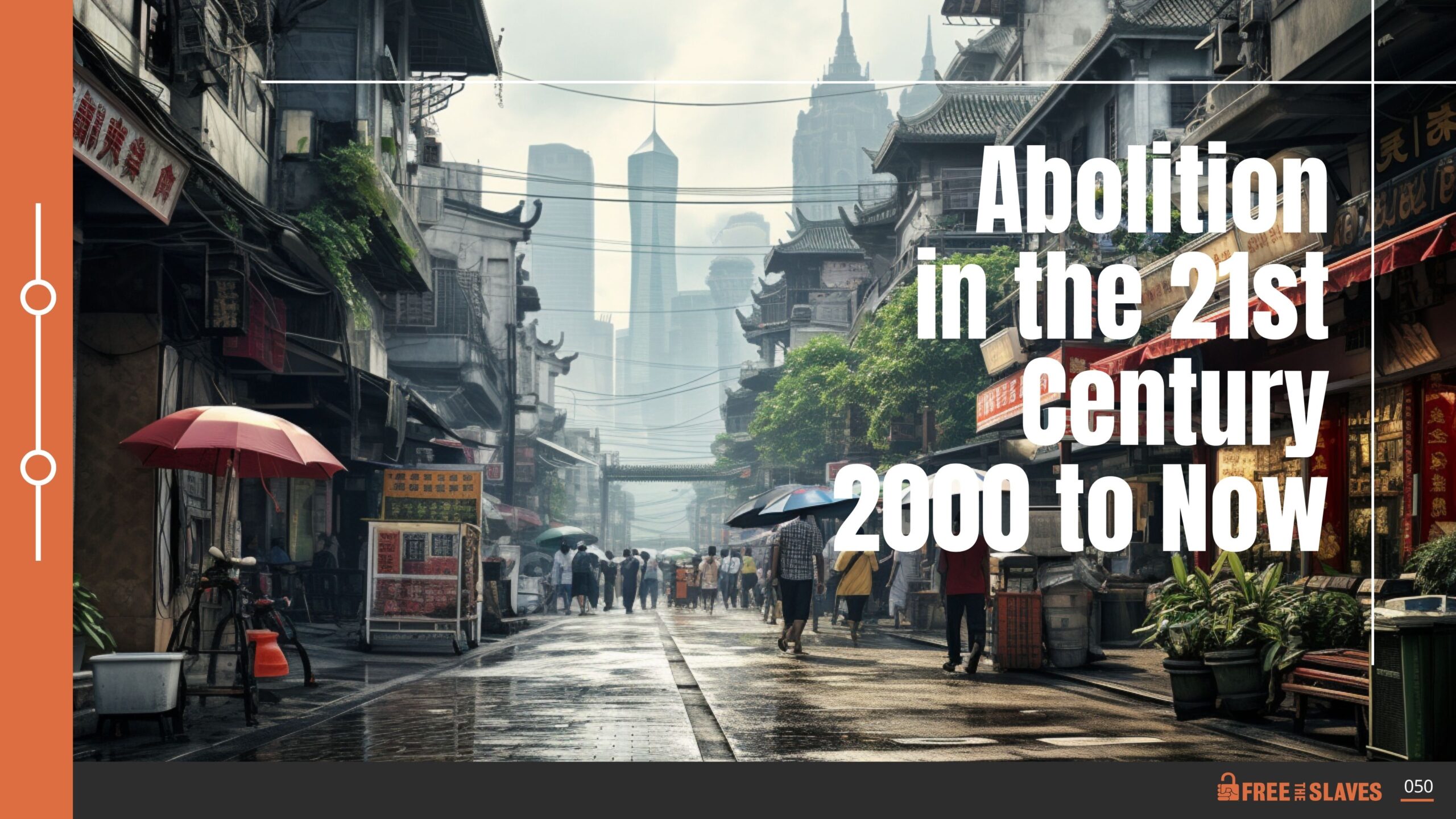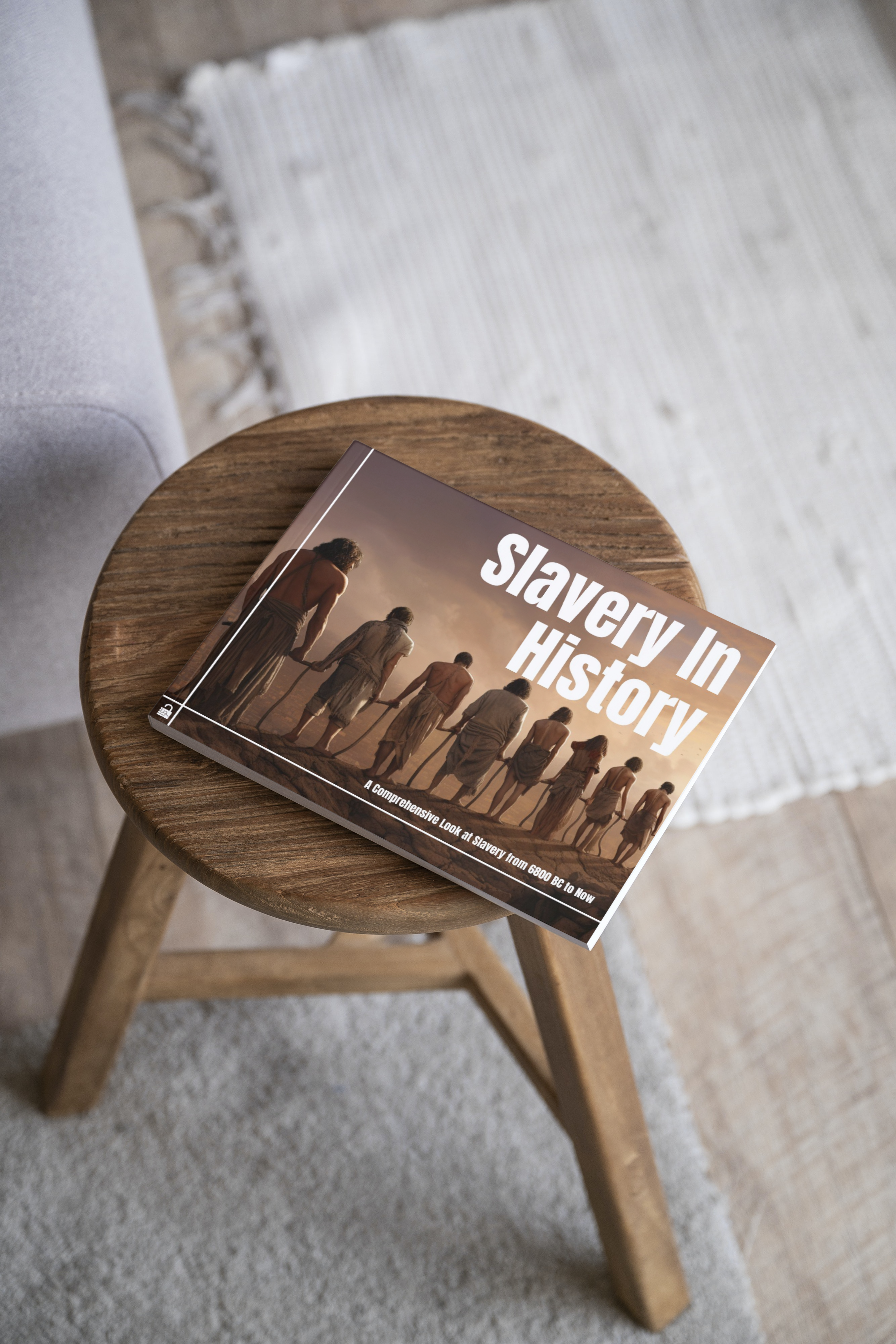Slavery In History
Below is a detailed timeline of slavery across human history, examining the institution’s evolution across various civilizations and historical eras from its earliest recorded instances in 6800 BC to the present day.
For those interested in delving deeper into this complex subject, a free eBook is available for download below. The eBook expands on the timeline, providing further context, illustrations, and analysis for a more comprehensive understanding of this pervasive institution.
Click on the title and date to read more
Slavery’s Roots: War and Economic Domination 6800 B.C to 1641
- 6800 B.C. The world’s first city-state emerges in Mesopotamia. Land ownership and the early stages of technology bring war—in which enemies are captured and forced to work: slavery.
- 2575 B.C. Temple art celebrates the capture of slaves in battle. Egyptians capture slaves by sending special expeditions up the Nile River.
- 550 B.C. The city-state of Athens uses as many as 30,000 slaves in its silver mines.
- 120 A.D. Roman military campaigns capture slaves by the thousands. Some estimate the population of Rome is more than half slave.
- 500 Anglo-Saxons enslave the native Britons after invading England.
- 1000 Slavery is a normal practice in England’s rural, agricultural economy, as destitute workers place themselves and their families in a form of debt bondage to landowners.
- 1380 In the aftermath of the Black Plague, Europe’s slave trade thrives in response to a labor shortage. Slaves pour in from all over the continent, the Middle East, and North Africa.
- 1444 Portuguese traders bring the first large cargo of slaves from West Africa to Europe by sea—establishing the Atlantic slave trade.
- 1526 Spanish explorers bring the first African slaves to settlements in what would become the United States. These first African-Americans stage the first known slave revolt in the Americas.
- 1550 Slaves are depicted as objects of conspicuous consumption in much Renaissance art.
- 1641 Massachusetts becomes the first British colony to legalize slavery.
The Age of Abolition 1781 to 1920
- 1781 Holy Roman Emperor Joseph II abolishes serfdom in the Austrian Habsburg dominions.
- 1787 The Society for the Abolition of the Slave Trade is founded in Britain.
- 1789 During the French Revolution, the National Assembly adopts the Declaration of the Rights of Man, one of the fundamental charters of human liberties. The first of 17 articles states: “Men are born and remain free and equal in rights.”
- 1791 Slaves in Haiti revolt, leading to Haiti’s independence from France in 1804 and the history’s only example of a slave rebellion leading to the creation of an independent nation where slavery was banned
- 1803 Denmark-Norway becomes the first country in Europe to ban the African slave trade, forbidding trading in slaves and ending the importation of slaves into Danish dominions.
- 1807 The British Parliament makes it illegal for British ships to transport slaves and for British colonies to import them. U.S. President Thomas Jefferson signs into law the Act Prohibiting Importation of Slaves, forbidding the importation of African slaves into the United States.
- 1811-1867 Operating off the Atlantic coast of Africa, the British Navy’s Anti-Slavery Squadron liberates 160,000 slaves.
- 1813 Sweden, a nation that never authorized slave traffic, consents to ban the African slave trade.
- 1814 The king of the Netherlands officially terminates Dutch participation in the African slave trade. At the Congress of Vienna, the assembled powers proclaim that the slave trade should be abolished as soon as possible but do not stipulate an actual effective date for abolition.
- 1820 The government of Spain abolishes the slave trade south of the Equator—but it continues in Cuba until 1888.
- 1833 The Factory Act in Britain establishes a working day in textile manufacture, provides for government inspection of working conditions, bans the employment of children under age 9, and limits the workday of children between 13 and 18 years of age to 12 hours.
- 1834 The Abolition Act abolishes slavery throughout the British Empire, including British colonies in North America. The bill emancipates slaves in all British colonies and appropriates nearly $100 million in today’s money to compensate slave owners for their losses.
- 1840 The new British and Foreign Anti-Slavery Society calls the first World Anti-Slavery Convention in London to mobilize reformers and assist post-emancipation efforts throughout the world. A group of U.S. abolitionists attends, but Elizabeth Cady Stanton and Lucretia Mott, as well as several male supporters, leave the meeting in protest when women are excluded from seating on the convention floor.
- 1845 The British Navy assigns 36 ships to its Anti-Slavery Squadron, making it one of the largest fleets in the world.
- 1848 The government of France abolishes slavery in all French colonies.
- 1850 The government of Brazil ends the country’s participation in the slave trade and declares slave traffic to be a form of piracy.
- 1861 Alexander II emancipates all Russian serfs, numbering about 50 million. His decree begins the Great Reform in Russia and earns him the title “Czar Liberator.”
- 1863 President Abraham Lincoln issues The Emancipation Proclamation, freeing all U.S. slaves in states that had seceded from the Union, except for those in Confederate areas already controlled by the Union army.
- 1863 The government of the Netherlands takes official action to abolish slavery in all Dutch colonies.
- 1865 Congress gives final passage to, and a sufficient number of states ratify, the 13th Amendment to the U.S. Constitution to outlaw slavery. The amendment reads: “Neither slavery nor involuntary servitude, except as a punishment for crime whereof the party shall have been duly convicted, shall exist within the United States, or any place subject to their jurisdiction.”
- 1888 The Lei Aurea, or Golden Law, ends slavery in South America when the legislature of Brazil frees the country’s 725,000 slaves.
- 1865-1920 Following the American Civil War, hundreds of thousands of African Americans are re-enslaved in an abusive manipulation of the legal system called “peonage.” Across the Deep South, African-American men and women are falsely arrested and convicted of crimes, then “leased” to coal and iron mines, brick factories, plantations, and other dangerous workplaces. The formal peonage system slows down after World War I but doesn’t fully end until the 1940s. However, in recent years, activists have noted that the 13 Amendment to the U.S. Constitution does not outlaw prison slavery, and that requiring inmates to work in prison industries today constitutes a continuing form of modern slavery.
Abolition Spreads Worldwide 1909 to 1949
- 1909 The Congo Reform Association, founded in Britain, ends forced labor in the Congo Free State, today the Democratic Republic of the Congo. After years of anti-slavery activism, the association’s Red Rubber Campaign stops the brutal system of Belgium’s King Leopold II, whose officials forced local people to produce rubber for sale in Europe and terrorized those who refused, cutting off their hands and burning down their houses.
- 1910 The International Convention for the Suppression of the White Slave Trade, signed in Paris, is the first of its kind, obligating parties to punish anyone who recruits a woman or girl under age into prostitution, even if she consents.
- 1913 After a public outcry galvanized by media reports and subsequent peoples’ petition, the British Parliament shuts down the Peruvian Amazon Company, a British entity that was torturing and exploiting indigenous Indians in Peru.
- 1915 The colonial government of Malaya officially abolishes slavery.
- 1918 The British governor of Hong Kong estimates that the majority of households that could afford it keep a young child as a household slave.
- 1919 The International Labor Organization (ILO) is founded to establish a code of global labor standards. Headquartered in Geneva, the ILO unites government, labor, and management to make recommendations concerning pay, working conditions, trade union rights, safety, woman and child labor, and social security.
- 1923 The British colonial government in Hong Kong bans the selling of little girls as domestic slaves.
- 1926 The League of Nations approves the Slavery Convention, which defines slavery as “status or condition of a person over whom any or all of the powers attaching to the right of ownership are exercised.” More than 30 governments sign the document, which charges all member nations to work to suppress all forms of slavery.
- 1926 Burma abolishes legal slavery.
- 1927 Slavery is legally abolished in Sierra Leone, a country founded as a colony by the British in the 18th century to serve as a homeland for freed slaves.
- 1930 The U.S. Tariff Act prohibits the importation of products made with “forced or indentured labor.” (In 1997, the Sanders Amendment clarified that this applies to products made with “forced or indentured child labor.”)
- 1936 The King of Saudi Arabia issues a decree that ends the importation of new slaves, regulates the conditions of existing slaves, and provides for manumission—the act of slave owners freeing their slaves—under some conditions.
- 1938 The Japanese military establishes “comfort stations”—actually brothels—for Japanese troops. Thousands of Korean and Chinese women are forced into sex slavery during World War II as military “comfort women.”
- 1939-1945 The German Nazi government uses widespread slave labor in farming and industry. Up to nine million people are forced to work to absolute exhaustion—then they are sent to concentration camps.
- 1941 The Adoption of Children Ordinance Law in Ceylon, now Sri Lanka, requires the registration of all children who are adopted and regular inspections to prevent adopted children from working as slaves.
- 1948 The Universal Declaration of Human Rights, created by the United Nations, provides: “No one shall be held in slavery or servitude; slavery and the slave trade shall be prohibited in all their forms.”
- 1949 The Convention for the Suppression of the Traffic in Persons and Exploitation of the Prostitution of Others prohibits any person from procuring, enticing, or leading away another person for the purposes of prostitution, even with the other person’s consent. This forms the legal basis for international protections against traffic in people still used today.
Abolition in Recent Times 1950 to 1999
- 1950-1989 International anti-slavery work slows during the Cold War, as the Soviet Block argues that slavery can only exist in capitalist societies, and the Western Block argues that all people living under communism are slaves. Both new and traditional forms of slavery in the developing world receive little attention.
- 1954 China passes the State Regulation on Reform through Labor, allowing prisoners to be used for labor in the laogai prison camps.
- 1956 The Supplementary Convention on the Abolition of Slavery regulates practices involving serfdom, debt bondage, the sale of wives, and child servitude.
- 1962 Slavery is abolished in Saudi Arabia and Yemen.
- 1964 The sixth World Muslim Congress, the world’s oldest Muslim organization, pledges global support for all anti-slavery movements.
- 1973 The U.N. General Assembly adopts the International Convention on the Suppression and Punishment of the Crime of Apartheid, which outlaws a number of inhuman acts, including forced labor, committed for the purposes of establishing and maintaining domination by one racial group over another.
- 1974 Mauritania’s emancipated slaves form the El Hor (“freedom”) movement to oppose slavery, which continues to this day. El Hor leaders insist that emancipation is impossible without realistic means of enforcing anti-slavery laws and giving former slaves the means of achieving economic independence. El Hor demands land reform and encourages the formation of agricultural cooperatives.
- 1975 The U.N. Working Group on Contemporary Forms of Slavery is founded to collect information and make recommendations on slavery and slavery-like practices around the world.
- 1976 India passes a law banning bonded labor.
- 1980 Slavery is abolished for the fourth time in the Islamic republic of Mauritania, but the situation is not fundamentally changed. Although the law decrees that “slavery” no longer exists, the ban does not address how masters are to be compensated or how slaves are to gain property.
- 1989 The National Islamic Front takes over the government of Sudan and begins to arm Baggara tribesmen to fight the Dinka and Nuer tribes in the south. These new militias raid villages, capturing and enslaving inhabitants.
- 1989 The U.N. Convention on the Rights of the Child promotes basic health care, education, and protection for the young from abuse, exploitation, or neglect at home, at work, and in armed conflicts. All countries ratify it except Somalia and the United States.
- 1990 After adoption by 54 countries in the 1980s, the 19th Conference of Foreign Ministers of the Organization of the Islamic Conference formally adopts the Cairo Declaration on Human Rights in Islam, which states that “human beings are born free, and no one has the right to enslave, humiliate, oppress, or exploit them.”
- 1992 The Pakistan National Assembly enacts the Bonded Labor Act, which abolishes indentured servitude and the peshgi, or bonded money, system. However, the government fails to provide for the implementation and enforcement of the law’s provisions.
- 1995 The U.S. government issues the Model Business Principles, which urges all businesses to adopt and implement voluntary codes of conduct, including the avoidance of child and forced labor, as well as discrimination based on race, gender, national origin, or religious beliefs.
- 1995 Christian Solidarity International, a Swiss-based charity, begins to liberate slaves in Southern Sudan by buying them back. The policy ignites widespread controversy—many international agencies argue that buying back slaves supports the market in human beings and feeds resources to slaveholders.
- 1996 The RugMark campaign is established in Germany to ensure that handwoven rugs are not made with slave or child labor. In 2010, RugMark changes its name to GoodWeave.
- 1996 The World Congress Against Commercial Sexual Exploitation of Children is held.
- 1997 The U.N. establishes a commission of inquiry to investigate reports of the widespread enslavement of people by the Burmese government.
- 1997 The United States bans imported goods made by child-bonded labor.
- 1998 The Global March against Child Labor is established to coordinate worldwide demonstrations against child labor and to call for a U.N. Convention on the Worst Forms of Child Labor.
- 1999 Despite being barred from entering Burma, the U.N. collects sufficient evidence to publicly condemn government-sponsored slavery, including unpaid forced labor and a brutal political system built on the use of force and intimidation to deny democracy and the rule of law.
- 1999 The ILO passes the Convention Against the Worst Forms of Child Labor, which establishes widely recognized international standards protecting children against forced or indentured labor, child prostitution and pornography, their use in drug trafficking, and other harmful work.
- 1999 The first global analysis of modern slavery and its role in the global economy, Disposable People: New Slavery in the Global Economy, estimates that there are 27 million people in slavery worldwide.
Abolition in the 21st Century 2000 to Now
- 2000 Free the Slaves is formed, originally as the sister organization of Anti-Slavery International in the U.K. Today Free the Slaves is an independent organization.
- 2000 The government of Nepal bans all forms of debt bondage after a lengthy campaign by human rights organizations and freed laborers.
- 2000 The U.S. Congress passes the Trafficking Victims Protection Act to combat the trafficking of persons as a form of modern slavery. The legislation increases penalties for traffickers, provides social services for trafficking victims, and helps victims remain in the country.
- 2000 The U.N. passes the Protocol to Prevent, Suppress, and Punish Trafficking in Persons as part of the Convention against Transnational Organized Crime. The trafficking protocol is the first global legally binding instrument with an internationally agreed-upon definition on trafficking in persons.
- 2001 Slavery: A Global Investigation—the first major documentary film about modern slavery—is released in the U.S. and Europe. The film tells the story of slavery and forced child labor in the cocoa and chocolate industry and wins a Peabody Award and two Emmy Awards.
- 2002 The countries of the Economic Community of Western African States agree on an action plan to confront slavery and human trafficking in the region.
- 2002 The International Cocoa Initiative is established as a joint effort of anti-slavery groups and major chocolate companies—marking the first time an entire industry has banded together to address slavery in its supply chain.
- 2004 Brazil launches the National Pact for the Eradication of Slave Labor, which combines the efforts of civil organizations, businesses, and the government to get companies to commit to the prevention and eradication of forced labor within their supply chains, as well as to be monitored and placed on a “dirty list” if the products they sell are tainted by slavery.
- 2004 The U.N. appoints a Special Rapporteur (Reporter) on Human Trafficking.
- 2005 The U.N. International Labor Organization’s first Global Report on Forced Labor puts the number of slaves worldwide at 12.3 million. The organization’s 2012 update increases the number to 20.9 million people.
- 2007 Ending Slavery: How We Free Today’s Slaves is published. Written by Free the Slaves co-founder Kevin Bales, it is the first plan for the global eradication of modern slavery, estimating the total cost of worldwide abolition at $10.8 billion over 25 years. President Bill Clinton highlights the plan at the Clinton Global Initiative. The book receives the 2011 University of Louisville Grawemeyer Award for Ideas Improving World Order.
- 2008 The Special Court for Sierra Leone judges forced marriage “a crime against humanity” and convicts three officers in the Revolutionary United Front of forced marriage—the first convictions of their kind within an international criminal tribunal.
- 2008 The U.N. International Labor Organization estimates that annual profits generated from trafficking in human beings are as high as $32 billion. In 2014 the organization increases that estimate to $150 billion in the report Profits and Poverty: The Economics of Forced Labor.
- 2010 Free the Slaves publishes Slavery, featuring images of slaves and survivors taken by humanitarian photographer Lisa Kristine and a foreword by South African Archbishop Emeritus Desmond Tutu. Kristine receives a 2013 Humanitarian Photographer of the Year Award from the Lucie foundation based in large part on her work with Free the Slaves.
- 2011 California enacts the California Transparency in Supply Chains Act, requiring major manufacturing and retail firms to publicly disclose what efforts, if any, they are taking to eliminate forced labor and human trafficking from their product supply chains.
- 2012 The U.S. Securities and Exchange Commission passes the Conflict Minerals Rule, requiring major publicly-held corporations to disclose if their products contain certain metals mined in the eastern Congo or an adjoining country and if payment for these minerals supports armed conflict in the region. The rule was required as part of the 2010 Dodd-Frank Wall Street Reform and Consumer Protection Act. Free the Slaves has documented that slavery is widespread at mining sites covered by this corporate disclosure requirement.
- 2013 The first Walk Free Global Slavery Index is released with country-by-country estimates for slavery worldwide. The research team estimates that 29.8 million people are enslaved today. The 2014 index increases that estimate to 35.8 million. The 2016 index increases that estimate to 45.8 million.
- 2015 Free the Slaves marks its 15th birthday by announcing that the organization has reached a historic benchmark—liberating more than 10,000 people from slavery.
- 2015 The U.N. adopts 17 Sustainable Development Goals, with 169 targets that include an end to slavery: “Take immediate and effective measures to eradicate forced labor, end modern slavery and human trafficking and secure the prohibition and elimination of the worst forms of child labor, including recruitment and use of child soldiers, and by 2025 end child labor in all its forms.”
- 2017 A research consortium including the U.N. International Labor Organization, the group Walk Free, and the U.N. International Organization for Migration release a combined global study indicating that 40 million people are trapped in modern forms of slavery worldwide: 50 percent in forced labor in agriculture, manufacturing, construction, mining, fishing and other physical-labor industries; 12.5 percent in sex slavery, and 37.5 percent in forced marriage slavery.
Many historical timeline entries are adapted from New Slavery: A Reference Handbook by Kevin Bales, Second Edition, Santa Barbara: ABC-CLIO, 2004, pp. 55-68.
Slavery In History
Sign-Up for the Newsletter to get this ebook for free.
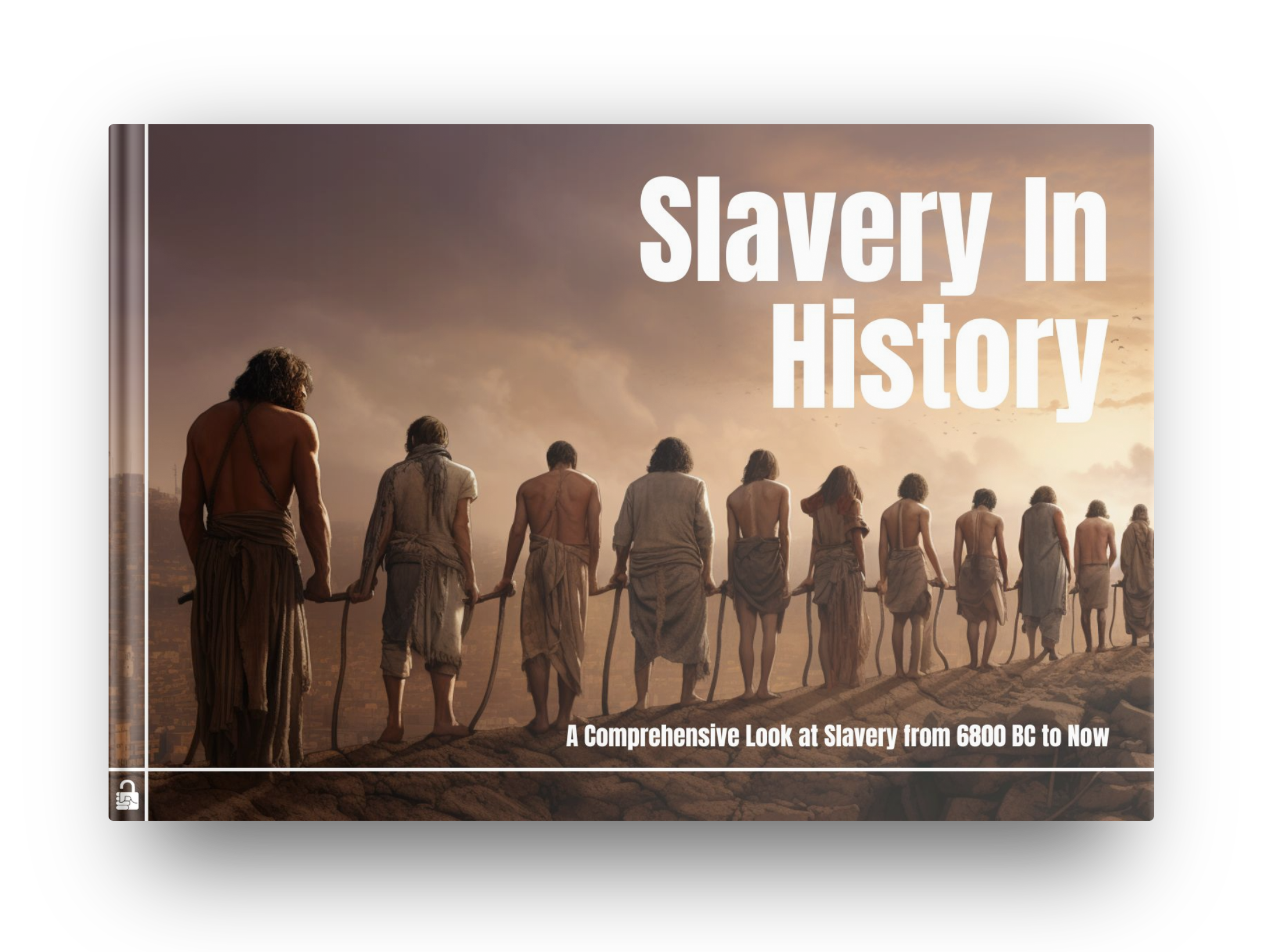
Discover the complex and multifaceted history of slavery from ancient civilizations to modern-day movements in our in-depth eBook. This illustrated and expanded companion to our interactive timeline delves deeper into the economic factors, cultural beliefs, and social norms that have shaped and reinforced the institution of slavery across various societies. Learn about the significant events, key figures, and persistent undercurrents of resistance that have continually challenged the status quo. This is not just an archive of past transgressions, but a living narrative that reflects both humanity’s failings and its potential for change, resilience, and progress.
Introduction
5 Chapters
71 Pages
Slavery has been a pervasive institution, stretching across time and location, ever since the earliest days of human society. The chronology presented in this book begins in 6800 BC and runs through to our current era, offering a comprehensive view of how the practice has manifested in various forms and been influenced by a myriad of factors. Yet, the story of slavery is far from static; it has evolved in complexity, driven by economic conditions, social norms, political agendas, and even technological advancements.
Various civilizations have had different relationships with slavery, influenced by their own unique set of circumstances. While some societies were notorious for their slave-trading empires, others were marked by a more subdued form of servitude. The Ancient Egyptians, the Roman Empire, and the American South each offer distinct narratives on the slave-owner dynamic, revealing how economic needs often outweighed moral considerations. The kinds of labor slaves performed could be as different as the pyramids they built, the battles they fought, or the cotton they harvested.
Economic factors alone, however, cannot explain the longevity and prevalence of slavery. Cultural beliefs and social norms have often served to reinforce the institution. Many societies have justified the enslavement of certain groups based on race, religion, or ethnicity, incorporating these prejudices into their legal and social frameworks. Yet, as dominant as these factors have been, there have been persistent undercurrents of resistance and reform that have slowly but steadily eroded the pillars of slavery.
Public opinion on slavery has been anything but monolithic and has shifted dramatically over time. What was socially acceptable or legally permissible in one era became the target of public outcry in another. Abolitionist movements, both quiet and loud, have existed alongside slavery, driven by individuals, religious groups, and even nations that have come to see the practice as antithetical to human dignity and social progress.
As you explore the events and milestones documented in this book, you’ll discover the multifaceted nature of slavery and the equally complex efforts to eradicate it. This is not merely an archive of past transgressions but a living narrative that continues to evolve. The history of slavery offers us a mirror, reflecting not just the failings of human society but also its capacity for change, resilience, and progress.
Chapter 1
As we delve into the earliest chapters of humanity’s recorded history, tracing the origins and evolution of slavery presents a profound challenge. The time spanning from 6800 BC to 1641 is characterized by the limited remnants of oral traditions, ancient inscriptions, artifacts, and the sparse documentation by early historians and explorers. Each fragment serves as a crucial piece of a vast, intricate puzzle, giving us glimpses into the genesis and growth of one of history’s most enduring and contentious institutions.
During these millennia, two predominant factors emerged as foundational pillars for the rise of slavery: war and economic domination. Tribal conflicts, territorial conquests, and vast empire expansions often resulted in the subjugation of entire populations. The victors, driven by both a desire for dominance and a practical need to manage the conquered, turned to enslavement. These war captives, stripped of their autonomy and rights, found themselves thrust into a life of servitude, their value reduced to their capacity for labor.
Parallel to the narrative of war is the tale of economic growth and ambition. As ancient civilizations evolved, their needs expanded. Monumental architectural endeavors, agricultural expansions, and the intricate web of trade routes demanded a substantial labor force. Slavery emerged as a pragmatic solution, promising cheap and controlled labor. Societal hierarchies solidified, with economic gain often prioritized over ethical considerations.
In “Slavery’s Roots: War and Economic Domination,” we will journey through vast empires, from Mesopotamian city-states to the medieval kingdoms of Europe. We’ll discover how the intertwined forces of war and economic ambition fueled the establishment and perpetuation of slavery. Along the way, we’ll grapple with the contradictions of human nature: the simultaneous capacity for creation and destruction, compassion and cruelty, progress and oppression. Through the lens of these early millennia, we’ll seek to understand the deep-seated roots of a system that has profoundly shaped the course of human history.
Get the ebook for free when you sign-up for the newsletter below
Sample Pages
The journey through the annals of slavery—from its earliest roots to the more recent manifestations—serves not just as an intellectual exercise, but as a reservoir of lessons and insights crucial for contemporary action. Understanding the history of slavery illuminates the multi-faceted complexities of this pervasive issue and equips us to deal with its current versions more effectively.
Get it Now!
Sign up to receive the Free The Slaves Newsletter and get the ebook for free.
Ready to test your knowledge?
Play Curious has created a game to help readers review the dates, locations, and numbers around the history of slavery.

